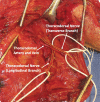Alternative Nerve Transfer for Shoulder Function: Thoracodorsal and Medial Triceps to Anterior Axillary Nerve
- PMID: 36299819
- PMCID: PMC9592485
- DOI: 10.1097/GOX.0000000000004614
Alternative Nerve Transfer for Shoulder Function: Thoracodorsal and Medial Triceps to Anterior Axillary Nerve
Abstract
We describe a reliable approach for double nerve transfer of the medial triceps branch and thoracodorsal nerve to the axillary nerve to increase axonal input. We present a review of outcomes for both end-to-end and reverse end-to-side nerve transfer.
Methods: A retrospective review of patients who underwent nerve transfer for improvement of shoulder abduction at Harborview Medical Center and Northwestern Memorial Hospital between 2012 and 2021 was conducted. Patients were prospectively contacted to fill out a 30 item Disabilities of the Arm, Shoulder and Hand questionnaire, with an option to upload a video demonstrating active range of motion.
Results: Twenty-one patients with 23 affected extremities were included in the final analysis. Fifteen patients completed the prospective arm of the study (71% response rate). Seventy-nine percent of patient limbs achieved a Medical Research Council Motor Scale (MRC-MS) of 4 or greater, and measured shoulder abduction active range of motion (AROM) was 139.2 degrees (range, 29-174 degrees) and 140.9 degrees (range, 60-180 degrees) (P = 0.95) for end-to-end and reverse end-to-side, respectively. Comparing end-to-end with reverse end-to-side neurorrhaphy, outcomes, including follow-up, mean postoperative MRC-MS, mean change in MRC-MS, Disabilities of the Arm, Shoulder and Hand, abduction AROM, and flexion AROM, were not statistically different.
Conclusions: We showed improvements in shoulder abduction with the thoracodorsal nerve, in addition to the medial triceps branch, to increase axonal donation and power the axillary nerve without sacrificing the spinal accessory nerve. Furthermore, we demonstrated improvements with reverse end-to-side coaptation when intraoperative stimulation of the axillary nerve revealed residual function.
Copyright © 2022 The Authors. Published by Wolters Kluwer Health, Inc. on behalf of The American Society of Plastic Surgeons.
Figures







References
-
- Leechavengvongs S, Witoonchart K, Uerpairojkit C, et al. . Nerve transfer to deltoid muscle using the nerve to the long head of the triceps, part II: a report of 7 cases. J Hand Surg Am. 2003;28:633–638. - PubMed
-
- Witoonchart K, Leechavengvongs S, Uerpairojkit C, et al. . Nerve transfer to deltoid muscle using the nerve to the long head of the triceps, part I: an anatomic feasibility study. J Hand Surg Am. 2003;28:628–632. - PubMed
-
- Khair MM, Schreiber JJ, Rosenblatt L, et al. . Axon counts yield multiple options for triceps fascicular nerve to axillary nerve transfer. J Hand Surg Am. 2016;41:e405–e410. - PubMed
-
- Chuang DC, Lee GW, Hashem F, et al. . Restoration of shoulder abduction by nerve transfer in avulsed brachial plexus injury: evaluation of 99 patients with various nerve transfers. Plast Reconstr Surg. 1995;96:122–128. - PubMed
LinkOut - more resources
Full Text Sources
